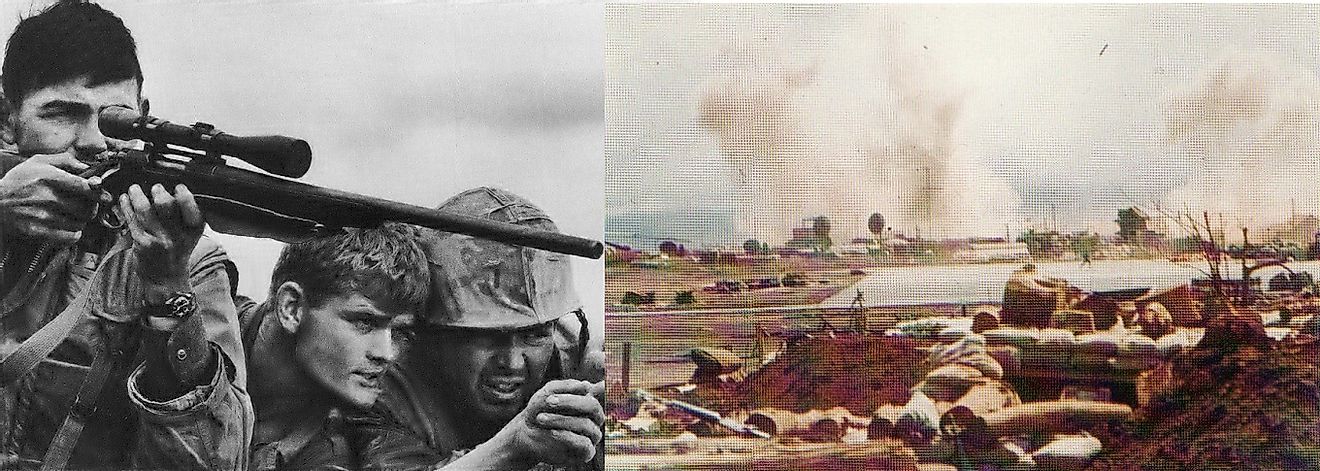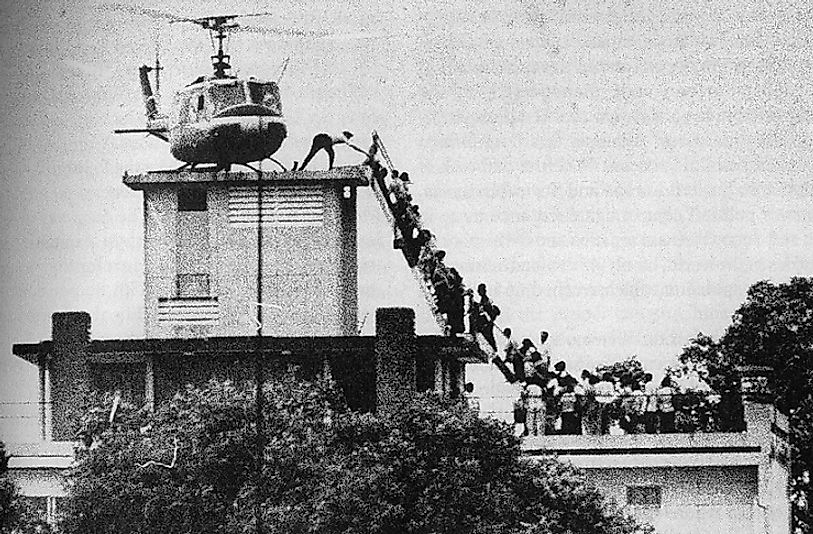Major Battles Of The Vietnam War

The Vietnam War started as a result of the United States' strategy of "containment", which was intended to minimize the spread of communism throughout the world during the Cold War. Vietnam was a temporarily separated into the North Communist and South anti-communist after the signing of Geneva treaty in 1954 which also brought an end to the French Colony. The French lost control of Vietnam towards the end of the Korean War. With the U.S. fearing that Vietnam will also fall under the control of the Communists intervened to try and keep the South Vietnam from falling. Their intervention led to the outbreak of several battles which have been collectively referred to as the Vietnam War.
10. Battle of Ia Drang -
The Battle of la Drang is considered to be the first major engagement between the U.S. Army and the Vietnam’s People Army (PAVN). It was a two-part battle which took place from November 14 to 18, 1965 at the la Drang Valley, South Vietnam. Both sides suffered major casualties with both claiming victory of their own. The Battle of la Drang was considered essential because it sets up a change of tactics for both troops during the conflict. The U.S. Army used air mobility and artillery to achieve their objectives while the Vietnam Army neutralized the U.S. Army by fighting at close range.
9. Battle of Khe Sanh -
The Battle of Khe Sanh took place at Khe Sanh in South Vietnam in the province of Quang Tri. The engagement took place from January 21, 1968, to April 9, 1968. The engagement began when the People’s Army of Vietnam (PAVN) bombarded the U.S. Marine garrison leading to an extensive battle which lasted 77 days until Operation Pegasus ended the engagement. The Battle of Khe Sanh was among the longest battles to be fought during the Vietnam War. The U.S. Army had to abandon the battle for the first time because of the pressure from the enemy. Despite the heavy casualty, both sides claimed victory.
8. Tet Offensive -
The Tet Offensive was a large military offensive during the Vietnam War which was initiated at the end of January in 1968. The engagement was launched by the Viet Cog and the North Vietnamese (PAVN) against the South Vietnamese Army (ARVN) troops and those of the U.S. The initial attacks stunned the U.S. and the ARVN causing them to lose control of several cities. However, they quickly regrouped and launched an offensive which inflicted heavy casualty on the PAVN army. The battle was fought for two months ending on March 28, 1968. The Tet Offensive had a profound effect on the U.S. Government and its citizens because they had been made to believe that the PAVN had been weakened and was unable to launch such an aggressive military operation.
7. Battle of Huế -
The Battle of Huế was one of the bloodiest and longest battles fought during the Vietnam War. During the battle, the forces of the U.S. Army, ARVN, and the U.S. Marine Corps fought and defeated the PAVN and the Viet Cong. Hue was an important city for the U.S. Army and its allies because Highway 1 which passed through the city was an important supply line. The city was also a base for U.S. Navy supply boat. However, the Hue was poorly defended and had few fortifications. The Viet Cong had attacked and occupied several cities including the Hue while the ARVN army concentrated on the cancellation of the Tet. Over the next month, from January 31, 1968, to February 28, 1968, the PAVN and Viet Cong armies were driven out in an intense fighting with the Allies declaring victory. However, the city of Hue was destroyed with 5,000 civilians killed.
6. Operation Rolling Thunder -
Operation Rolling Thunder was a progressive and sustained aerial campaign carried out by the 2nd Air Division of the U.S. Navy and the South Vietnam Air Force (VNAF) forces against the North Vietnamese from March until November of 1968. The objective of Operation Rolling Thunder was to uplift the spirit of the Saigon Regime in North Vietnam, to convince North Vietnam to withdraw its support for the communist army in South Vietnam, to cut-off the transportation system of the North Vietnam, and to stop the material flow into South Vietnam. The operation was the most intense battle ever conducted during the Cold War. Most of the air-to-air lose for the U.S. Army was due to the unseen attacks from the rear.
5. Battle of Hamburger Hill -
The Battle of Hamburger Hill was fought between the ARVN with U.S. Army support against the PAVN for eleven days from May 10th through May 20th in 1969. The engagement was conducted on Hill 937 which was renamed Hamburger Hill due to its grinding nature. The Battle of Hamburger Hill was a part of the Operation Apache Snow whose goal was to clear the PAVN forces from Shau Valley. Despite the hill being of little strategic value to the U.S., it caused unnecessary casualties. The Battle of Hamburger Hill also led to the diminishing of the popularity of the conflict since many felt that the battle was pointless and many doubted whether or not the U.S. should be involved in Vietnam further.
4. Easter Offensive of 1972 -
The Easter Offensive was conducted by the PAVN against the ARVN and the U.S. troops between March and October of 1972 in the wake of the failed Operation Lam Son 719 of 1971. It was launched partly to influence the 1972 U.S. Presidential Election, and also to improve North Vietnam’s negotiating position during the peace talks in Paris. The attack was launched by the PAVN in three fronts simultaneously. PAVN’s success was hindered by the heavy casualty and the U.S.'s destructive air power. The ARVN forces managed to recapture Quang Tri and other bases from the PAVN forces. However, the North Vietnam gained a better bargaining power despite the defeat.
3. Operations Linebacker I & II -
Operations Linebacker I & II were U.S. Air Force and Navy campaigns which were conducted against the North Vietnamese at the latter period of the U.S. involvement in the Vietnam War. Operations Linebacker I was held from May to October 1972 while Operations Linebacker II was held from December 18 to 29, 1972. The first operation was held to slow transportation of material for the Easter Offensive while the second operation was to major target complexes in Hanoi area. The attacks led to severe damage to the North Vietnam infrastructure. Millions of gallons of petroleum products were also destroyed in the process.
2. Battle of Xuân Lộc -
The Battle of Xuân Lộc was the final major battle to be fought during the Vietnam War. It was fought between April 9th and April 20th of 1975 in and around the town of Xuan Loc. It was the last effort by the last ARVN military to stop the progress of the PAVN troops and save the South Vietnam after its major defeat in the city of Hue. The ARVN troops were forced to withdraw from the battle line due to the isolation of the town. The Battle of Xuân Lộc was a blow to the ARVN and South Vietnam’s leadership leading to the resignation of President Thieu. The gateway to Saigon was finally opened for the PAVN forces.
1. Fall of Saigon -

The victory at Xuan Loc opened up the door for the PAVN forces to conquer Saigon, the South Vietnamese capital. Over 100,000 troops of the PAVN surrounded the city by April 27, 1975, with only 60,000 ARVN troops left to defend their capital. However, most of the ARVN troops joined the people who were walking out of the city. The fall of Saigon was sealed by the evacuation of the U.S. Forces bringing an end to the Vietnam War on April 30, 1975, and leading to the reunification of Vietnam and the strengthening of communism throughout the entire country.











